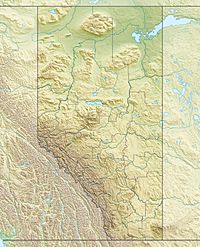Apex Mountain facts for kids
Quick facts for kids Apex Mountain |
|
|---|---|
| Highest point | |
| Elevation | 3,250 m (10,660 ft) |
| Prominence | 510 m (1,670 ft) |
| Geography | |
| Location | Alberta / British Columbia, Canada |
| Parent range | Park Ranges |
| Topo map | NTS 83C/04 |
| Climbing | |
| First ascent | 1922 by A. Carpe, H.S. Hall |
Apex Mountain is a tall peak located right on the border between Alberta and British Columbia in Canada. It was given its name in 1927. This mountain stands in the middle of a large area of ice and snow called the Clemenceau Icefield. It reaches an elevation of 3,250 meters (about 10,660 feet) above sea level.
Contents
What is Apex Mountain?
Apex Mountain is part of the Canadian Rockies, a huge mountain range in western North America. It's known for its impressive height and its location within a large icefield. Mountains like Apex are important for understanding Earth's history and climate.
How Apex Mountain Formed
Apex Mountain is made of sedimentary rock. This type of rock forms from layers of sand, mud, and tiny bits of ancient sea creatures that settle at the bottom of oceans over millions of years.
Ancient Seas and Rock Layers
- The rocks that make up Apex Mountain were laid down during the Precambrian to Jurassic periods.
- This means the rocks are incredibly old, ranging from over 540 million years ago to about 145 million years ago.
- These layers formed in shallow seas that once covered this area.
Mountain Building Event
- Later, a huge event called the Laramide orogeny happened.
- This was a period when massive forces deep within the Earth pushed and folded the land.
- During this time, the sedimentary rock layers were pushed eastward.
- They were even pushed up and over younger rock layers, creating the tall mountains we see today, like Apex Mountain.
Weather at Apex Mountain
The climate at Apex Mountain is known as a subarctic climate. This means it has very specific weather patterns throughout the year.
Cold Winters and Mild Summers
- Winters at Apex Mountain are typically very cold and snowy.
- Temperatures can drop below −20 °C (which is about −4 °F).
- With the wind chill, it can feel even colder, sometimes below −30 °C (−22 °F).
- Summers, however, are usually mild, offering a break from the extreme cold.
Understanding the Climate
- Scientists use something called the Köppen climate classification system to describe climates around the world.
- This system helps categorize different regions based on their temperature and precipitation patterns.
- Apex Mountain's subarctic climate is typical for high-altitude areas in northern regions.


